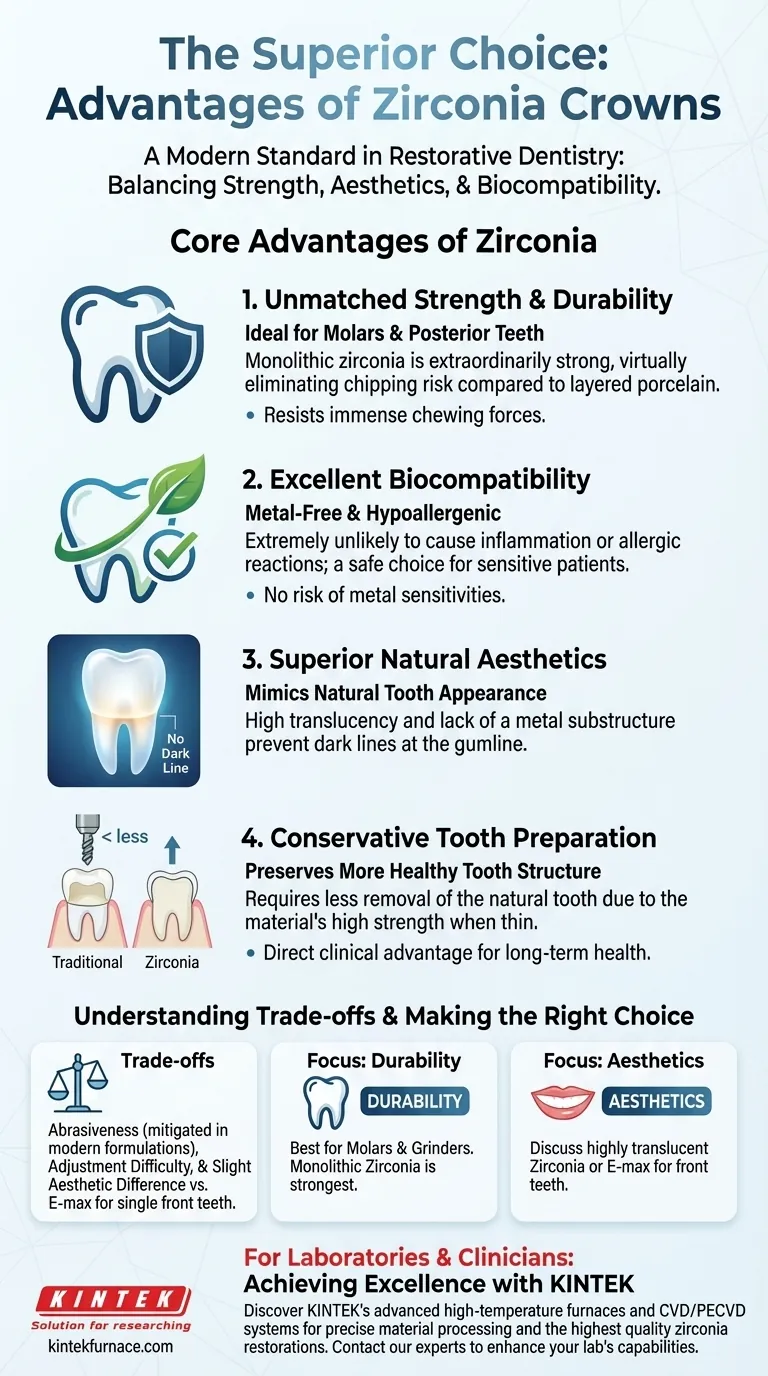In short, zirconia crowns offer a superior combination of strength, aesthetics, and biocompatibility compared to many traditional crown materials. A key advantage is that their inherent durability allows for a thinner crown, which often means less of your natural tooth needs to be removed during preparation, preserving more of its original structure.
Zirconia represents a significant evolution in dental materials, effectively bridging the gap between the brute strength of metal crowns and the aesthetic appeal of all-ceramic crowns. It has become a modern standard by offering a high-performance solution without many of the traditional compromises.
The Core Advantages of Zirconia
Zirconia is a ceramic material (zirconium dioxide) with exceptional properties that make it highly suitable for dental restorations. These advantages address the most common goals in restorative dentistry: longevity, appearance, and patient health.
Unmatched Strength and Durability
Zirconia is extraordinarily strong and resistant to fracture. This makes it an ideal material for crowns on posterior teeth (molars), which endure immense chewing forces.
Monolithic zirconia crowns, made from a single block of the material, are particularly robust and virtually eliminate the risk of chipping that can occur with layered porcelain crowns.
Excellent Biocompatibility
As a metal-free ceramic, zirconia is highly biocompatible. This means it is extremely unlikely to cause allergic reactions or gum inflammation, which can sometimes be an issue with the metal alloys used in Porcelain-Fused-to-Metal (PFM) crowns.
This makes it a safe and predictable choice for nearly all patients, especially those with known metal sensitivities.
Superior Natural Aesthetics
Modern zirconia materials have been engineered for excellent translucency, allowing them to mimic the appearance of natural teeth with remarkable accuracy.
Unlike PFM crowns, zirconia crowns have no metal substructure. This completely avoids the common issue of a dark or gray line appearing at the gumline, ensuring a more natural and stable cosmetic result over time.
Conservative Tooth Preparation
The exceptional strength of zirconia is a direct clinical advantage. Because the material can withstand force even when it is relatively thin, your dentist can be more conservative when preparing the tooth.
This means less of your healthy tooth structure needs to be removed to fit the crown. Preserving more of the natural tooth is always a primary goal for long-term dental health.
Understanding the Trade-offs
No material is perfect for every situation. While zirconia's advantages are significant, it's important to understand its specific characteristics and limitations to make an informed decision with your dentist.
Potential for Abrasiveness
Early formulations of zirconia had a reputation for being abrasive against the opposing natural teeth. However, modern zirconia materials, combined with proper polishing techniques by the dental lab and dentist, have largely mitigated this concern.
Aesthetic Nuances
While aesthetically excellent, the most translucent all-ceramic materials like lithium disilicate (E-max) may still have a slight edge in situations demanding the absolute highest level of cosmetic detail, such as for a single front incisor. The choice often depends on the specific location in the mouth and the desired balance of strength versus translucency.
Difficulty in Adjustment
Zirconia's hardness, while a benefit for durability, can make it more challenging for a dentist to adjust or remove once it has been permanently cemented in the mouth. This underscores the importance of a precise fit from the start.
Making the Right Choice for Your Goal
Your ideal crown material depends on the specific tooth being restored and your personal priorities. Discuss these goals with your dentist to determine the best path forward.
- If your primary focus is maximum durability: For a molar, or if you have a history of grinding your teeth, monolithic zirconia is arguably the strongest tooth-colored option available.
- If your primary focus is aesthetics for a front tooth: A highly translucent zirconia is an excellent choice, but you should also discuss other all-ceramic options like E-max to achieve the most lifelike result.
- If your primary focus is biocompatibility: Zirconia is a superior metal-free choice that eliminates the risks of metal allergies and gum discoloration associated with PFM crowns.
Ultimately, a well-made zirconia crown provides a balanced, durable, and highly aesthetic solution for most dental restoration needs.
Summary Table:
| Advantage | Key Benefit |
|---|---|
| Strength & Durability | Ideal for molars; monolithic zirconia virtually eliminates chipping. |
| Biocompatibility | Metal-free, hypoallergenic, and reduces risk of gum inflammation. |
| Aesthetics | Excellent translucency; no dark gumline for a natural appearance. |
| Tooth Preservation | Requires less removal of healthy tooth structure due to inherent strength. |
Ready to achieve a superior restoration with a zirconia crown? Discuss your specific needs and goals with your dentist to determine if this high-performance material is the right choice for your smile. For dental laboratories seeking to provide the highest quality zirconia restorations, KINTEK's advanced high-temperature furnaces and CVD/PECVD systems are essential for precise material processing and strong, aesthetic results. Contact our experts today to learn how our solutions can enhance your lab's capabilities.
Visual Guide

Related Products
People Also Ask
- Why is temperature range important when selecting a dental furnace? Unlock Material Compatibility and Precision
- What safety measures should be followed when using a sintering furnace in dental labs? Ensure Safe, High-Quality Dental Restorations
- What role does temperature range and accuracy play in dental furnace performance? Ensure Precision for Superior Dental Restorations
- What are the benefits of using dental sintering and porcelain furnaces? Enhance Strength, Aesthetics, and Efficiency
- What is the importance of dental furnaces in dentistry? Ensure Strong, Precise Dental Restorations
